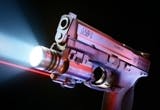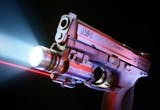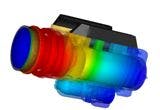“Upfront thermal analysis with CFdesign has enabled us to explore uncharted territories,” says Deepanjan Mitra, SureFire’s thermal analysis engineer. “It has given us the chance to virtually test ideas and optimize designs before physically prototyping the product.”
From incandescent to LED
According to Paul Kim, VP of engineering for SureFire, thermal analysis became necessary when the company’s products converted from incandescent illumination to high-powered LED lighting.
“In terms of thermal management, LEDs are like semiconductor devices,” says Kim. “As you put out more light, you generate more heat. The cooler we can run the device, the more photons, or light, we can put out.”
Unlike semiconductors, whose failure might be an inconvenience or cause a temporary loss of data, SureFire products are required to function at all times under extreme environmental conditions in the field.
“When we say mission-critical,” says Kim, “we mean that it must perform under all circumstances in all parts of the world. In many cases, the operation of the flashlight could make a difference between life and death.”
Integrated CAD and CFD
SureFire created the preliminary design for the X400 in Pro/ENGINEER, then opened it in CFdesign upfront CFD software. CFdesign is integrated with Pro/ENGINEER and other major CAD packages, so users can work directly on the CAD model, eliminating the translation step and data loss associated with traditional CFD software. The associativity between Pro/E and CFdesign provides flexibility to explore more options upfront in the design process, according to Mitra.
The quick analysis is followed by upfront analyses on full models with most of the cosmetic features, which can illustrate more complex interactions and also be used as a marketing tool to highlight new features.
Simulating flow-field conditions
An important capability of upfront CFD for SureFire is the ability to simulate flow-field conditions such as convection coupled with heat generation. The results from these simulations are used to generate transient simulations that give SureFire engineers a picture of how fast temperatures rise in the flashlight according to factors such as materials, heat-sink design, LED power, and fin spacing and design. Thermal analysis was crucial in two major aspects of X400 design according to Kim and Mitra: optimizing the design of housings, especially thermal isolation of the laser unit; and determining the best settings for thermal management firmware.
The X400 presents an additional challenge: isolating the laser housing. The laser diode needs to be maintained at a temperature well below that of the LED. Since the main lamp body is mechanically coupled to the laser housing for shock isolation, insulation is needed to minimize the amount of heat from the main lamp that reaches the laser housing.
SureFire used CFdesign to perform various “what-if” scenarios, balancing heat dissipation with the need to minimize the size and weight of the weapon-mounted light.
To determine housing material and insulation thicknesses, SureFire ran thermal simulations showing how fast heat traveled to the laser housing. The simulations enabled SureFire to predict when the laser diode would fail based on a visualized temperature field.
“We simulated a bunch of scenarios with different housing materials and insulation thicknesses, which led to us being able to determine design requirements,” says Mitra. “This is really simple, since it only amounts to changing the material property of the part in CFdesign and rerunning the analysis.”
The other major simulation area for the X400 was thermal management: A microprocessor in the flashlight regulates power to the LED based on feedback from sensors, controlling the overall temperature of the device. Simulations helped SureFire determine optimal settings for the thermal management firmware.
“Simulations showed us the thermal characteristics of the whole assembly,” says Kim. “Using the results, we could define a cut-off temperature at which to activate the microprocessor-based thermal management algorithm.”
Time savings and beyond
Using CFdesign software early in the design process eliminated three different design prototypes that SureFire would normally use for testing to ensure that design requirements are met. That translates into a savings of about 15 days, according to Kim. In other areas, time savings are harder to quantify, but readily evident.
“This would have been difficult to gauge with physical prototype experiments,” says Mitra. “We can now simulate different fin sizes, thicknesses, spacing and shape, then gauge the effects on the thermal performance of the flashlight. In a lot of cases, this could be no improvement, in which case we have saved a lot of time and resources by not making a physical prototype. In other cases, it could mean a tremendous improvement in thermal performance, helping us decide that this is the right design to prototype.
“Cut-section views, x-y plot flow vectors, and 3D temperature isotherms in CFdesign are all important visualization tools that help us make sense of the simulation results and compare them among different designs.”
A test bed to launch ideas
SureFire will continue to look for new innovations within its products that will help improve the safety and efficiency of military and law-enforcement personnel in both hometowns and far-flung areas of the world.
“We can now do things with upfront thermal simulation that used to take months and several design cycles to achieve by traditional methods,” says Kim.
“We will still innovate and draw on our experience and expertise to come up with new thermal management ideas,” says Mitra. “But CFdesign has provided us with a test bed to launch these ideas and in many cases has helped us reach concrete decisions that we can develop rapidly into practical concepts.”









